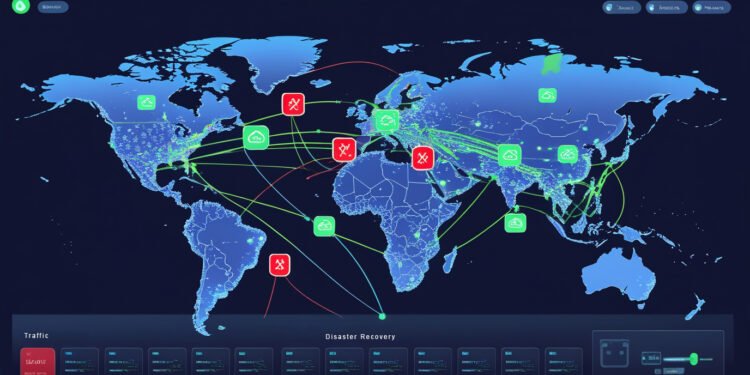By Marc Mawhirt
In the cloud era, downtime is a luxury no business can afford. Cyberattacks, natural disasters, regional outages, or cloud service failures can cripple operations in seconds—and your disaster recovery (DR) strategy needs to respond even faster.
Enter Global Server Load Balancing (GSLB)—the next-generation solution for building highly available, disaster-resilient architectures at global scale.
GSLB intelligently routes user traffic to multiple geographically dispersed data centers or cloud regions, ensuring high availability, optimal performance, and instant failover when things go wrong. It’s not just a traffic balancer—it’s your global resilience control plane.
🌍 What is Global Server Load Balancing?
GSLB is an advanced layer of load balancing that operates across geographically distributed infrastructure—data centers, public clouds, edge nodes, and hybrid environments. It makes routing decisions based on multiple dynamic factors:
- Health checks and server availability
- Geolocation and latency
- Application performance
- Traffic load and policy rules
When disaster strikes in one location, GSLB reroutes users to a healthy location instantly, without the need for DNS propagation delays or manual intervention.
🆚 Traditional Disaster Recovery vs GSLB: What’s the Difference?
| Feature | Traditional DR | GSLB-Enhanced DR |
|---|---|---|
| Failover Time | Minutes to hours | Sub-second |
| Manual Intervention | Often required | Fully automated |
| Traffic Control | Basic DNS or manual switch | Smart routing based on health/performance |
| Global Redundancy | Limited | Built-in across multiple regions |
| Observability | Fragmented | Unified, real-time dashboard |
With GSLB, disaster recovery becomes continuous, intelligent, and automated—a critical evolution for organizations that can’t afford downtime.
🔎 Key Benefits of GSLB for Disaster Recovery
⚡ 1. Sub-Second Failover
No more waiting for DNS records to propagate or relying on outdated failover scripts. GSLB platforms can automatically detect outages through constant health checks and reroute traffic within milliseconds.
🌐 2. Multi-Region Redundancy
By spreading workloads across multiple clouds, regions, or data centers, GSLB ensures high availability—even during regional blackouts or infrastructure failures.
🤖 3. Automated Traffic Optimization
GSLB doesn’t just balance—it optimizes. It routes users to the closest, fastest, or healthiest server, improving performance and reliability simultaneously.
📉 4. Minimized Revenue Loss
By reducing or eliminating downtime, GSLB protects brand trust and revenue, especially for ecommerce, banking, healthcare, and SaaS platforms.
👁️ Integrating 360-Degree Visibility into Your DR Strategy
Modern GSLB platforms come with deep observability features, allowing you to:
- Monitor server health and application performance across regions
- Receive real-time alerts for outages, latency spikes, or degraded experiences
- Visualize global traffic flows and identify regional performance issues
- Audit failover events and policy changes for compliance
This 360-degree view turns disaster response from reactive to proactive—empowering IT teams to get ahead of failures before users feel them.
🖥️ Unified Dashboard: The Nerve Center of Resilience
Legacy DR often relies on a patchwork of tools. GSLB replaces that chaos with a single-pane-of-glass dashboard where ops teams can:
- View all global endpoints and traffic health
- Configure load balancing policies (latency-based, geolocation, weighted, etc.)
- Simulate failover scenarios with live drills
- Integrate with DNS, CDNs, and observability tools
- Roll out policy changes globally in minutes
This consolidation boosts response times and reduces human error during live incidents—when it matters most.
🛡️ GSLB and Security: An Overlooked Advantage
Disaster recovery isn’t just about availability—it’s also about securing continuity. GSLB platforms integrate with security policies and Zero Trust architectures:
- Enforce TLS and IP-based access rules at the edge
- Integrate with WAFs and DDoS protection upstream
- Route traffic away from compromised or under-attack regions
- Maintain uptime during regional ransomware or botnet events
By sitting at the edge of your infrastructure, GSLB becomes a first line of defense as well as a recovery tool.
🏥 GSLB Use Cases Across Industries
- SaaS: Ensure application uptime across cloud regions; enable rolling updates without service interruption
- Healthcare: Maintain EMR system access across hospitals—even during regional outages
- Finance: Preserve transaction continuity and latency-sensitive services via proximity routing
- Retail: Avoid ecommerce downtime during high-traffic events or platform failures
- Government: Provide uninterrupted citizen services via cloud and edge redundancy
🔄 How to Integrate GSLB Into Your Stack
Most leading platforms—F5, NS1, Cloudflare, Azure Front Door, AWS Global Accelerator—offer GSLB functionality that integrates with:
- Public clouds (AWS, Azure, GCP)
- DNS providers
- CDNs and WAFs
- Monitoring tools like Datadog, Prometheus, Grafana
- CI/CD pipelines for policy-as-code routing configs
Implementing GSLB doesn’t mean ripping and replacing—it’s about smart layering into your existing stack.
Final Thoughts: Build for Failure, Route for Survival
No system is immune to failure. But with Global Server Load Balancing, failure doesn’t have to mean downtime. GSLB transforms disaster recovery into a dynamic, intelligent, and continuous process—one that protects your users, your brand, and your bottom line.
If your business lives online, GSLB isn’t a luxury. It’s a modern necessity.


















